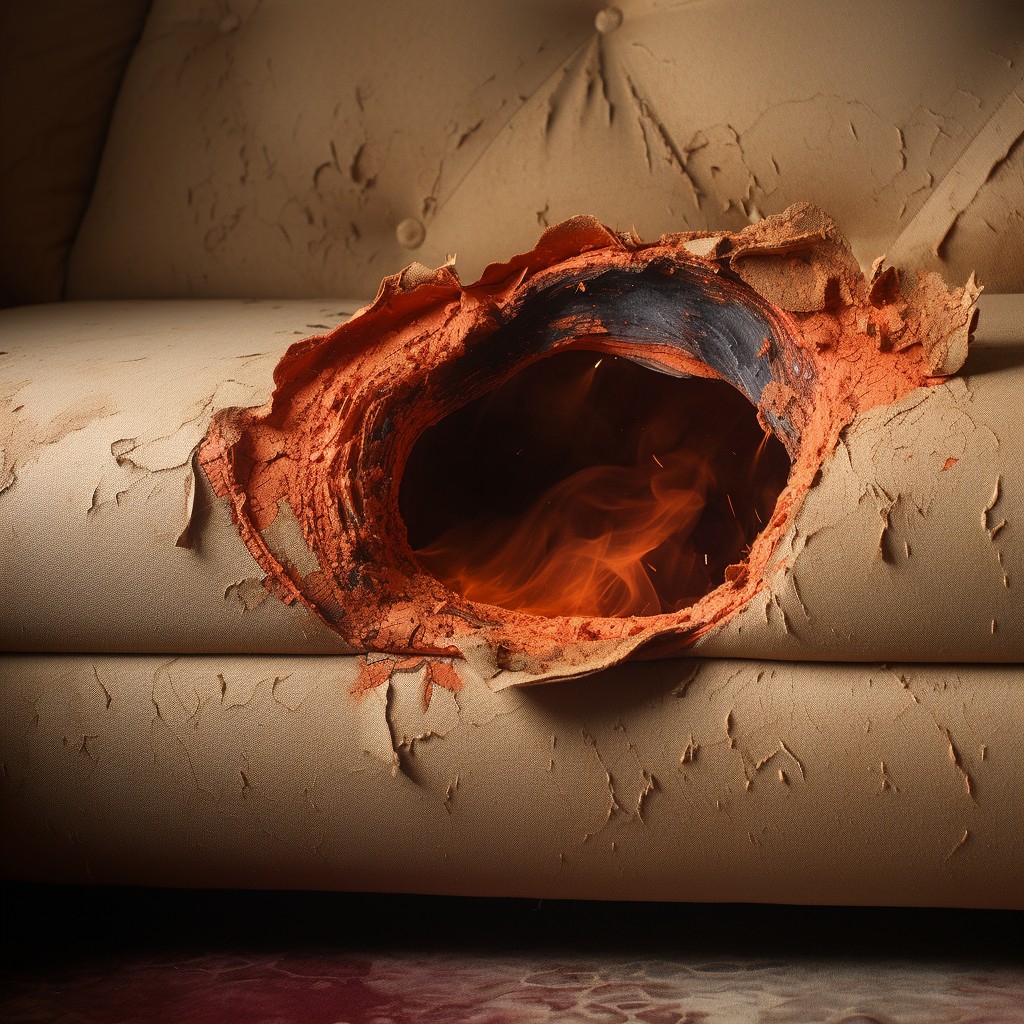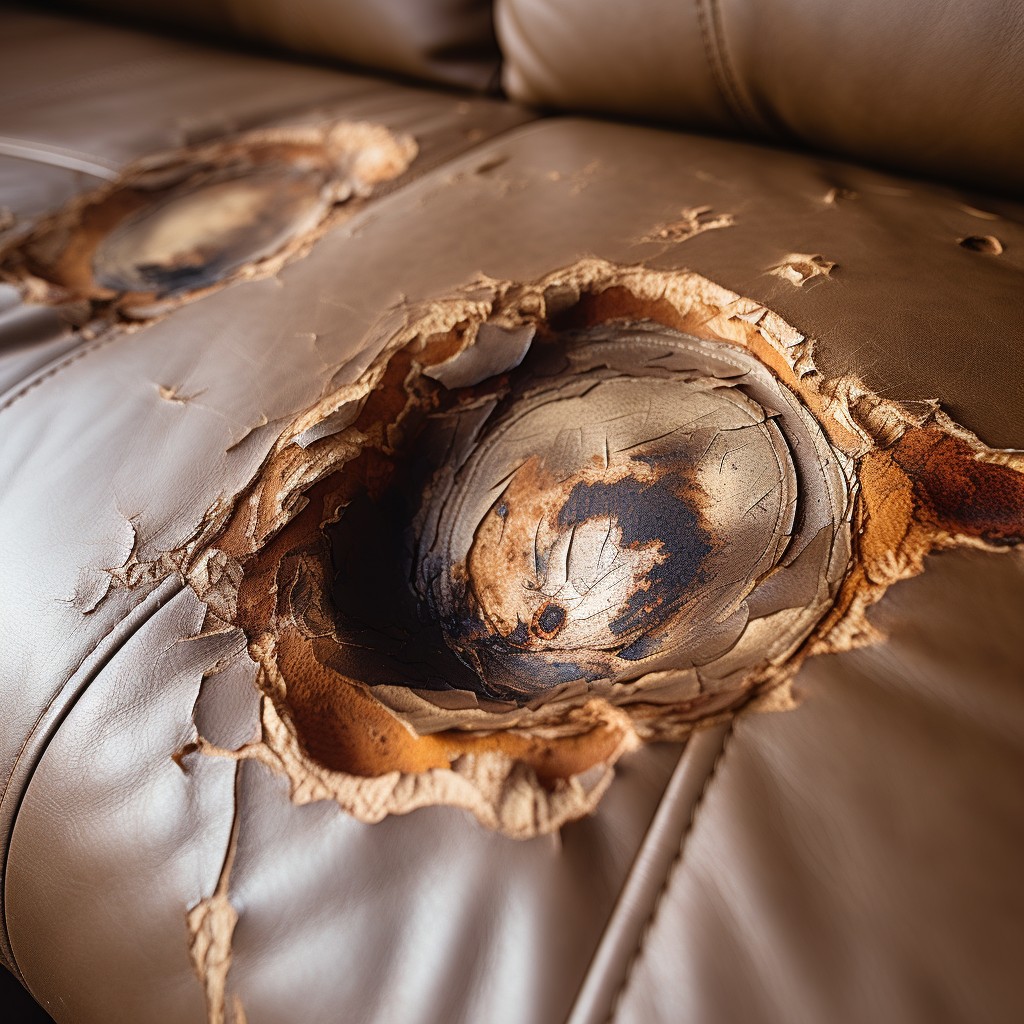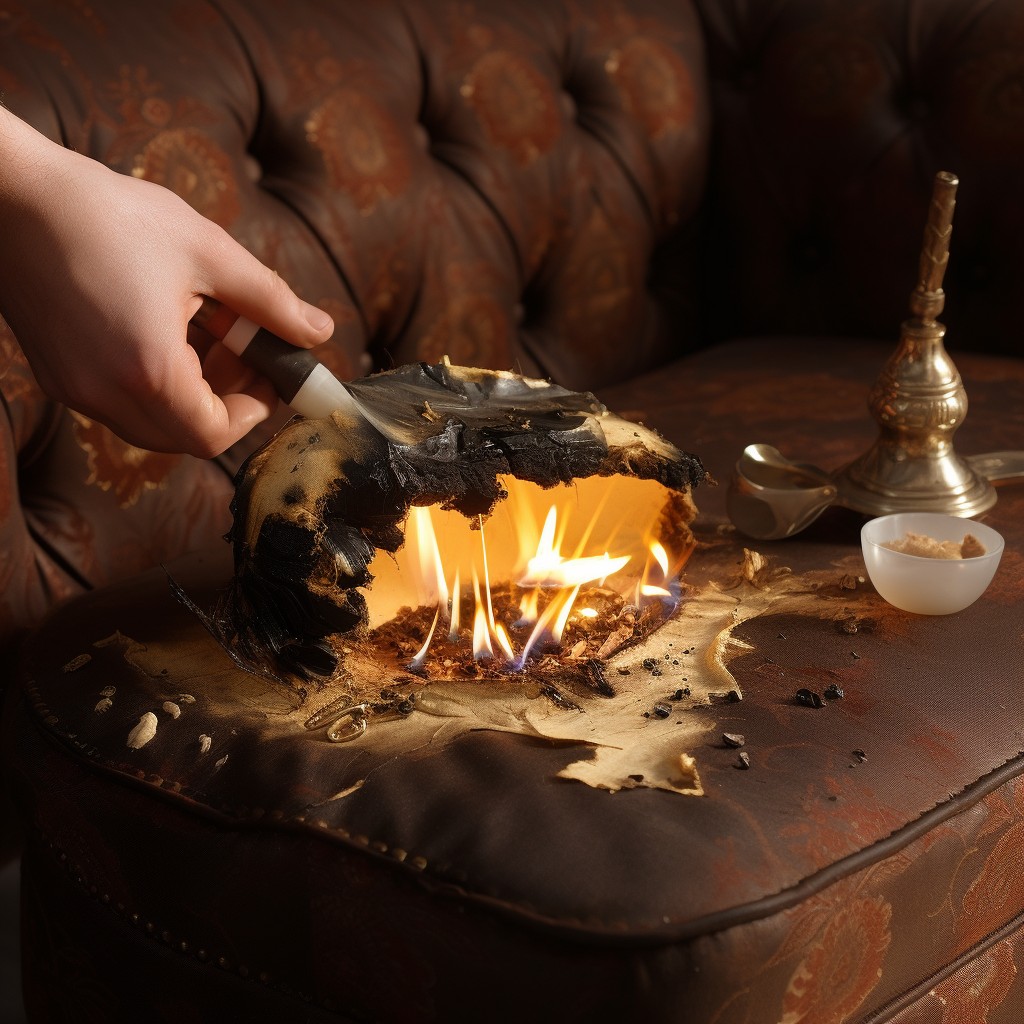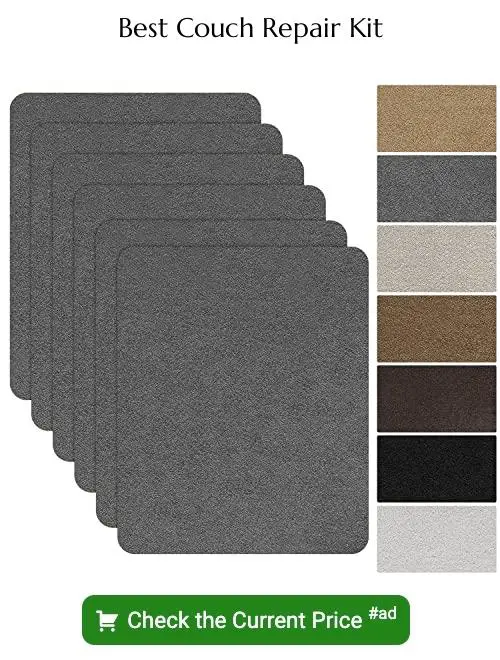Last updated on
Discover the simple steps to effectively repair a burn hole in your couch, restoring its original appearance and charm.
Have you ever accidentally burned a hole in your couch? It’s a common mishap that can happen to anyone. Whether it’s from a cigarette, hot iron, or even a candle, burn holes can be an eyesore and decrease the value of your furniture.
But don’t worry, there’s no need to throw out your beloved couch just yet. With the right tools and some patience, you can easily fix that burn hole yourself! In this article, we’ll walk you through step-by-step on how to fix a burn hole in a couch so it looks as good as new.
Table of Contents
Assess the Damage

The first step in repairing a burn hole in your couch is to assess the damage. The size and location of the burn will determine how you go about fixing it.
If the hole is small, less than an inch or so, then you may be able to fix it yourself with some simple tools and materials. However, if the burn is larger or located on a prominent area of your couch such as on an armrest or cushion, then professional repair services may be necessary.
To assess the damage accurately:
- Identify where exactly on your couch has been burned.
- Measure how big (or deep) that spot is.
- Check whether there are any other damages around that area.
Once you have assessed these factors carefully, you can decide whether to proceed with DIY repairs or seek professional help for more extensive damages.
Assessing the Burn Damage

Depending on the size and location of the burn, you may need to use different repair methods. If it’s a small hole, you can easily fix it with some fabric glue or by sewing a patch over it.
However, if the burn is larger or has damaged more than just the surface of your couch upholstery, then you may need to replace cushion foam or even seek professional help.
To assess how deep and wide the damage goes into your couch material, gently pull apart any burnt fibers around its edges using tweezers until there are no loose threads left hanging out from around its perimeter. This will give you an idea of how much area needs repairing.
Once that’s done inspecting for any other damages like discoloration caused by heat exposure should be checked as well since this could affect color matching during repairs later on.
Gather Repair Materials

Depending on the size and location of the burn hole, you may need different supplies. Here are some basic items that will come in handy for most repairs:
1. Fabric patch – Choose a fabric patch that matches your couch upholstery as closely as possible.
2. Scissors – You’ll need scissors to cut out a piece of fabric for your patch.
3. Fabric glue or heat bond tape – These adhesives can be used to attach the fabric patch onto the damaged area.
4. Needle and thread (optional) – If you prefer sewing over using adhesive, then needle and thread is necessary.
5. Sandpaper- Sandpaper helps smoothen rough edges around burnt holes.
6. Upholstery cleaner- This is important if there are stains around or near burnt holes.
7. Cushion foam replacement (if needed)- In case there’s extensive damage beyond just burns.
Gathering Repair Supplies

The good news is that most of these items can be found at your local craft store or online. Here are some essential repair materials you’ll need:
1. Fabric patch: Choose a fabric patch that matches the color and texture of your couch upholstery.
2. Scissors: You’ll need scissors to cut out a piece of fabric for the patch.
3. Fabric glue: This will help secure the patch in place.
4. Needle and thread (optional): If you prefer sewing, use needle and thread instead of fabric glue.
5. Tweezers (optional): Use tweezers to remove any loose threads around the burn hole before applying a patch.
6- Heat bond tape or iron-on patches.
7- Microfiber cloth.
8- Leather filler kit.
9 – Sandpaper.
10 – Upholstery cleaner.
Choose a Repair Method
There are several ways to fix a burn hole in your couch, and the best one for you will depend on factors such as the size of the hole and type of fabric.
One option is patching with fabric. This involves cutting out a piece of matching upholstery fabric and gluing or sewing it over the burn hole.
Another option is using heat bond tape that can be ironed onto both sides of small holes.
If color matching is important, consider using color-matching techniques like dyeing or painting over an area around your repaired spot so that it blends seamlessly into its surroundings.
For larger holes or more complex repairs, professional sofa burn repair services may be necessary. These experts have specialized tools and materials needed to restore furniture back to its original condition without compromising quality or durability.
Patching With Fabric
This method involves cutting out a piece of fabric that matches your couch’s upholstery and gluing or sewing it onto the damaged area.
To start, you’ll need to gather some supplies such as scissors, matching upholstery fabric, and either glue or thread and needle. Begin by assessing the size of the burn hole; if it’s small enough (less than an inch), then cut out a piece of matching fabric slightly larger than the hole itself.
Next, apply some glue around the edges of your cut-out patch before carefully placing it over top of your burned area. If you’re using thread instead, sew around all four sides until securely attached.
Once complete let dry for at least 24 hours before sitting on or using again.
Color Matching Techniques
If you don’t match the color correctly, it will be obvious that there was a repair done on your couch. There are several techniques to help you achieve an accurate color match.
Firstly, try to find fabric swatches or samples from when you first purchased your couch. These can be used as reference points for matching colors and textures.
If this isn’t possible, take pictures of different areas of your couch under natural light and bring them with you when shopping for repair materials. This will help ensure that any new material closely matches the original upholstery.
Another option is to use dye or paint specifically designed for upholstery repairs. These products come in various shades and can be mixed together until they create an exact match with your furniture’s original hue.
Applying Fabric Glue
Here’s how to do it:
- Clean the area around the burn hole with soap and water.
- Cut a piece of fabric that is slightly larger than the size of the burn hole.
- Apply fabric glue around the edges of the burn hole on both sides of your couch cushion or upholstery.
- Place your cut-out patch over it, making sure that it covers all edges completely.
- Press down firmly on top so that there are no air bubbles left underneath.
Allow time for drying as per instructions provided by manufacturer before using again.
While this method may not be as durable as other options like sewing or heat bonding, applying fabric glue can provide an affordable temporary fix until you have more time or resources available for further repairs.
Sewing the Patch
This is an effective way to fix small burn holes in fabric upholstery. First, cut a piece of fabric that is slightly larger than the hole itself.
Then, place it over the hole and pin it into place.
Next, thread your needle with matching thread and tie a knot at one end of the thread. Starting from underneath the patch, insert your needle through both layers of fabric about 1/4 inch away from where you tied off your knot.
Continue sewing around all four sides of the patch until you reach where you started stitching again on top of where you began stitching initially (this will create two parallel lines). Tie off any loose ends by making knots or using fray check glue if needed.
Replacing Cushion Foam
This process is relatively simple and can be done with just a few tools. First, remove the damaged cushion from your couch and unzip it to access the foam inside.
Measure its dimensions so that you can purchase new foam of equal size.
Once you have your new foam, place it into the cover of your old cushion and zip it up tightly. If necessary, trim any excess material around edges for a snug fit.
Repairing With a Heat Bond
This method is ideal for small holes that are less than an inch in diameter. Here’s how to do it:
- Cut out a piece of heat bond tape that is slightly larger than the size of the hole.
- Place the tape over the burn hole, making sure it covers all edges.
- Use an iron on low heat setting and press down firmly on top of where you placed your patch until it adheres.
Heat bonding works by melting adhesive material onto both sides of fabric or leather surfaces which then bonds them together when cooled down again – creating one seamless surface without any visible seams or patches! It’s important not to use too high temperature as this can cause damage instead; always start at lower temperatures first before increasing gradually if necessary until desired results are achieved.
Using a Fabric Repair Kit
These kits come with everything you need to patch up the hole and restore the appearance of your furniture.
To use a fabric repair kit, start by cleaning the area around the burn hole with soap and water. Once it’s dry, cut out a piece of patch material from one of the included swatches that matches your couch’s upholstery color as closely as possible.
Next, place some adhesive on both sides of the patch material and position it over top of where you want to cover up that unsightly burn mark. Press down firmly on all edges so they stick together securely before allowing time for drying according to manufacturer instructions.
Fixing a Burn Hole in Microfiber Couch
They can still fall victim to burn holes just like any other upholstery material. The good news is that fixing a burn hole in microfiber is relatively simple.
To start, assess the size of the burn hole and gather your repair materials. You’ll need some fabric glue or adhesive, scissors, tweezers (if necessary), and a small piece of matching microfiber fabric.
Next, cut out a small patch from the matching fabric that’s slightly larger than the burned area. Apply some glue to both sides of the patch before carefully placing it over the damaged spot on your couch.
Press down firmly on all edges of your new patch with clean fingers or use an object such as a spoon handle to ensure it adheres well without leaving any air bubbles underneath.
Allow ample time for drying according to manufacturer instructions before testing its strength by gently tugging at its edges with tweezers or fingertips – if there’s no movement then you’re done!
Mending a Cigarette Burn Hole
Cigarette burns can be particularly tricky to repair because they often leave behind black marks and melted fabric. However, there are ways to mend the damage caused by cigarette burns.
To fix a cigarette burn hole in your couch, start by assessing the extent of the damage. If it’s just a small hole without any discoloration or melting around it, you may be able to patch it up using fabric glue or sewing techniques as outlined earlier in this article.
However, if there is significant discoloration and melting around the burn hole caused by cigarettes’ heat intensity on upholstery fabrics like polyester blends or nylon fibers that melt easily when exposed for long periods of time – then repairing becomes more challenging.
Upholstery Repair Services
These professionals have the expertise and tools necessary to fix even the most severe burns and tears. They can also provide color matching services so that any patches blend seamlessly with your existing upholstery.
When choosing an upholstery repair service, be sure to do some research beforehand. Look for reviews from previous customers and ask about their experience repairing burn holes specifically.
You’ll want to find a reputable company that offers fair pricing and quality workmanship.
While professional repairs may cost more than doing it yourself, they can save you time and ensure that your couch looks as good as new when all is said and done. Plus, many companies offer warranties on their work so you can rest assured knowing that if anything goes wrong down the line, they’ll take care of it at no additional cost.
Professional Sofa Burn Repair Services
These services can be found at furniture stores, upholstery shops, and even online. Professional repair technicians have the expertise and tools necessary to restore your couch’s appearance seamlessly.
However, it’s important to note that professional repairs can come with a hefty price tag depending on the extent of damage and type of fabric used for upholstery. Before opting for this route, consider assessing if repairing is worth it compared to buying a new piece altogether.
Whether you choose DIY methods or opt for professional help when fixing a burn hole in your couch depends on personal preference and budget constraints.
Preventing Future Burn Holes
One of the easiest ways is by setting up a designated smoking area in your home and ensuring all cigarettes are properly extinguished before disposal. If you frequently use hot tools like irons or curling wands, make sure they’re placed on heat-resistant surfaces away from any furniture.
Another way to protect your couch is by using protective covers or throws when eating or drinking near it. This will help prevent accidental spills and stains that can be difficult to remove.
Regular cleaning and maintenance can also go a long way in preventing damage to your upholstery. Vacuuming regularly with an upholstery attachment helps remove dirt, dust, and debris that can cause wear over time.
Preventing Future Burn Damage
One of the easiest ways is by setting up designated smoking areas in your home and ensuring that all candles are placed on stable surfaces away from flammable materials.
If you frequently use hot styling tools like flat irons or curling wands, make sure to always place them on a heat-resistant mat when not in use. Be cautious with any open flames near upholstered furniture and never leave them unattended.
Another way to protect your couch is by investing in protective covers or throws for high-traffic areas. These can help shield against accidental spills and burns while also adding an extra layer of style.
Cleaning the Couch Post-Repair
This will not only remove any excess glue or residue from the repair process but also ensure that your couch looks as good as new.
Start by vacuuming the entire surface of your couch to remove any loose debris and dust. Then, use a damp cloth with mild soap and water to gently wipe down the repaired area.
Be sure not to scrub too hard or use harsh chemicals that could damage your upholstery.
If you’re unsure about what cleaning products are safe for your specific type of fabric, check with a professional cleaner or refer back to manufacturer guidelines.
Maintaining Couch Upholstery
Regular cleaning and maintenance can help extend the life of your furniture and keep it looking great for years to come.
To start, vacuum your couch regularly with a soft brush attachment or use a lint roller if you have pets that shed. This will remove any dirt or debris that may accumulate on the surface of the fabric.
If spills occur, clean them up immediately using a damp cloth and mild soap solution. Avoid using harsh chemicals as they can damage the fabric over time.
It’s also recommended to rotate cushions periodically so they wear evenly. This will prevent one side from becoming more worn than another which could lead to an uneven appearance over time.
By following these simple steps, you’ll be able to maintain your newly repaired couch in top condition for many years!
FAQ
Can you fix burn marks in a couch?
To fix burn marks in a couch, use hydrogen peroxide to keep the area moist, cover with a damp and dry cloth, and press with an iron as hot as safe for the fabric before rinsing well.
Can you fix a burn hole in microfiber couch?
To fix a burn hole in a microfiber couch, prepare the hole and position an iron-on fabric patch, then instead of sewing, simply iron the patch to the existing fabric.
Is it possible to repair burn damage on a leather couch?
Yes, it is possible to repair burn damage on a leather couch by using various methods such as patching, applying leather fillers, or re-dyeing the area.
What are the most effective methods for covering burn holes in fabric upholstery?
The most effective methods for covering burn holes in fabric upholstery include using fabric patches, upholstery paint, or fabric glue with matching fibers.
Can DIY techniques be used to successfully mend burn holes in various couch materials?
Yes, DIY techniques can be used to successfully mend burn holes in various couch materials.





